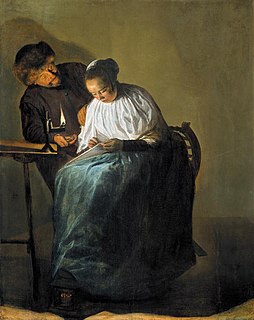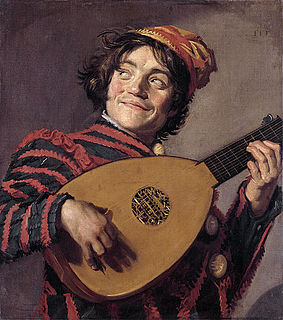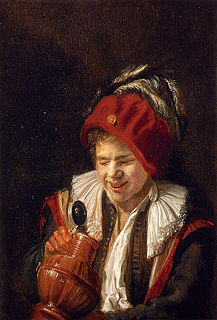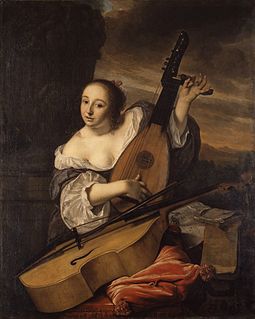
Bartholomeus van der Helst was a Dutch painter. Considered to be one of the leading portrait painters of the Dutch Golden Age, his elegant portraits gained him the patronage of Amsterdam's elite as well as the Stadtholder's circle. Besides portraits, van der Helst painted a few genre pictures as well as some biblical scenes and mythological subjects.

Judith Jans Leyster was a Dutch Golden Age painter. She painted genre works, portraits and still lifes. Although her work was highly regarded by her contemporaries, Leyster and her work became almost forgotten after her death. Her entire oeuvre was attributed to Frans Hals or to her husband, Jan Miense Molenaer, until 1893. It wasn't until the late 19th century that she was recognized for her artistic abilities.
Events from the year 1629 in art.
Events from the year 1620 in art.

Louis Finson, Lodewijk Finson or Ludovicus Finsonius was a Flemish painter, draughtsman, copyist and art dealer. He painted portraits, religious compositions, allegorical paintings and genre scenes. Moving to Italy early in his career, he became one of the first Flemish followers of Caravaggio whom he knew personally in Naples. He produced a number of copies after works by Caravaggio. He worked for a number of years in various cities in France where he created altarpieces and portraits. He is known for being the co-owner together with his fellow Flemish painter and business partner Abraham Vinck of two paintings by Caravaggio. Louis Finson played a major role in the Northern Caravaggesque movement through his own works as well as his role as an art dealer.

The Proposition is a genre painting of 1631 by Judith Leyster, now in the Mauritshuis in The Hague, who title it Man offering money to a young woman. It depicts a woman, sewing by candlelight, as a man leans over her, touching her right shoulder with his left hand. He is offering her coins in his right hand, but she is apparently ignoring the offer and concentrating intently upon her sewing. As we see the female protagonist ignore the advances of her suitor, this painting has been considered to potentially be a feminist work.

The Lute Player is an oil-on-canvas painting from 1623 or 1624 now in the Louvre by the Haarlem painter Frans Hals, showing a smiling actor wearing a jester's costume and playing a lute.

The Fingernail Test is an oil-on-canvas Dutch Golden Age painting that has been attributed to either Frans Hals or Judith Leyster, painted in 1626 and now in the Metropolitan Museum of Art, New York City.

Self-portrait by Judith Leyster is an Dutch Golden Age painting in oils now in the collection of the National Gallery of Art in Washington DC. It was offered in 1633 as a masterpiece to the Haarlem Guild of St. Luke. It was attributed for centuries to Frans Hals and was only properly attributed to Judith Leyster upon acquisition by the museum in 1949. The style is indeed comparable to that of Hals, Haarlem's most famous portraitist.

The Jolly Toper is a 1629 oil painting by Judith Leyster in the collection of the Rijksmuseum that is on long term loan to the Frans Hals Museum since 1959. It was acquired by the museum as a painting by Frans Hals and was attributed to Leyster by the researcher Juliane Harms in 1927.

The Serenade is a 1629 oil painting by Judith Leyster in the collection of the Rijksmuseum. It was attributed for centuries to Frans Hals until Wilhelm von Bode saw it in the Six collection in 1883. He noticed the prominent "J" in the signature, and attributed it to Jan Hals. This is one of seven paintings first properly attributed to Leyster by Hofstede de Groot ten years later in 1893.

The Last Drop is a c. 1629 oil painting by Judith Leyster in the John G. Johnson collection of the Philadelphia Museum of Art. It was regarded as a work by Frans Hals until 1903, when it was noticed that it is signed 'JL*' on the tankard.

A Youth with a Jug is a 1633 oil painting by Judith Leyster currently in a private collection.

Standing Cavalier is a painting by Judith Leyster in the Royal Collection. It is the only painting by Leyster with a provenance that reaches back to the 18th-century.

Young man playing the lute is an oil painting by Judith Leyster in the collection of the Rijksmuseum, and is a period copy of the same subject by Frans Hals. It was acquired by the museum as a painting by Frans Hals and was skipped by the researcher Juliane Harms in 1927, being finally attributed to Leyster by Seymour Slive in 1974.

A Boy and a Girl with a Cat and an Eel is a 1635 oil painting by Judith Leyster that is now in the National Gallery, London.

A Game of Tric-Trac is a painting by Judith Leyster from 1630.

The Musician (1662) is an oil on canvas painting by the Dutch painter Bartholomeus van der Helst. It is an example of Dutch Golden Age painting and is part of the collection of the Metropolitan Museum of Art.

Unequal Love is a painting made in about 1631 by the Dutch Golden Age painter Judith Leyster. It is in the collection of the Galleria Nazionale d'Arte Antica, Rome.



















